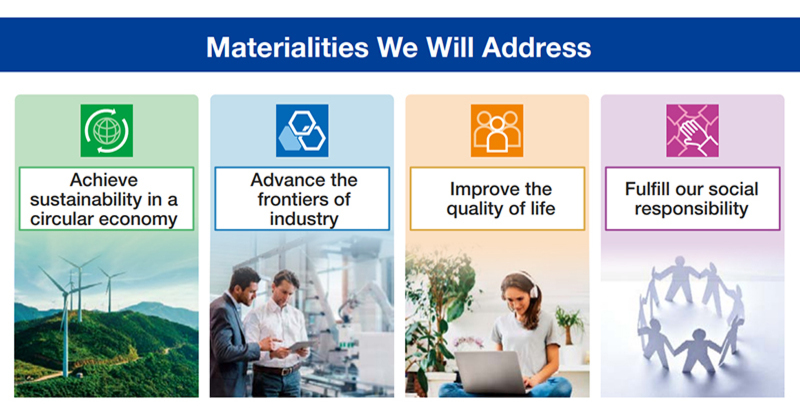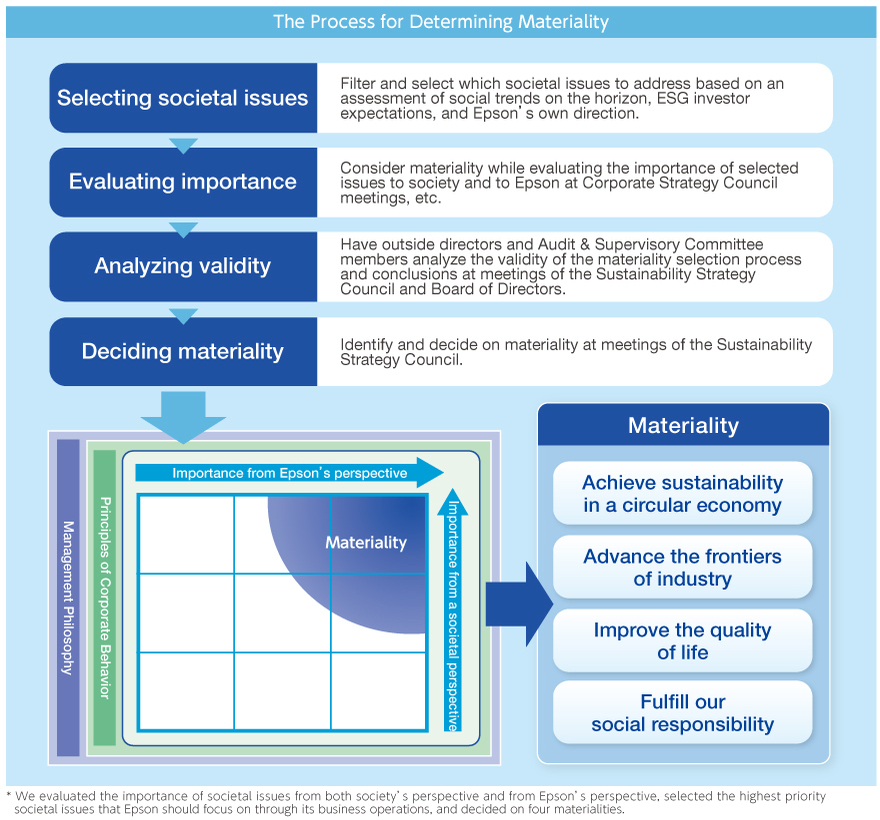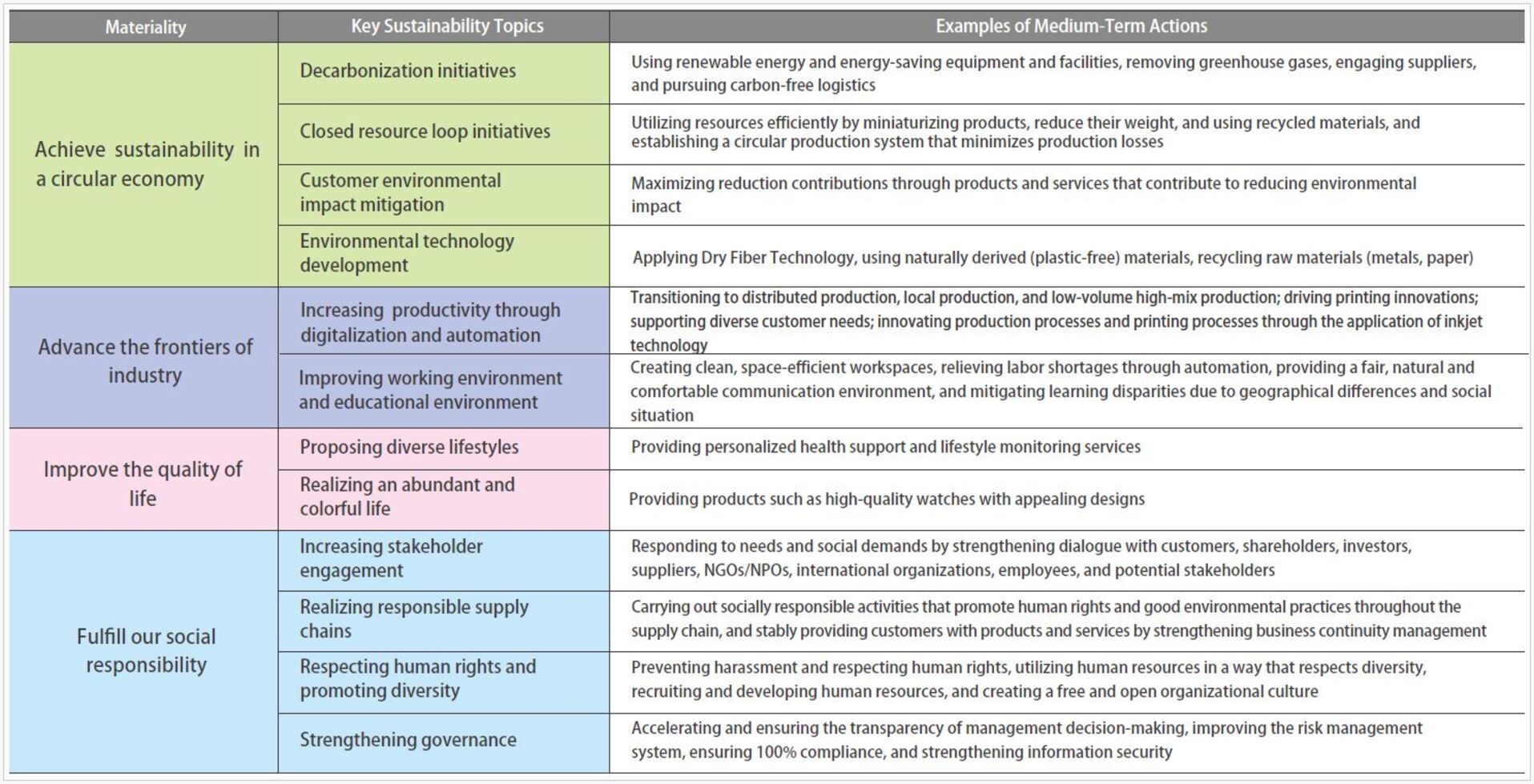Materiality and progress
Materiality
Epson’s corporate management is rooted in the concept of materiality. Materiality is identified based on the impact of societal issues. We consider Epson’s business activities to be a means of directly addressing these issues. Epson sees achieving sustainability in a circular economy, advancing the frontiers of industry, improving the quality of life and fulfill our social responsibility as key themes for solving societal issues.

- Achieve sustainability in a circular economy
This entails initiatives aimed at driving sustainable economic activities by achieving closed-resource-loop systems through effective use of resources such as electricity, energy and water as well as reduction in usage of underground resources to control climate change. - Advance the frontiers of industry
This entails initiatives aimed at transforming conventional processes to contribute to the resolution of social issues. It is intended to help to make improvements to environmental pollution, labor and other issues by converting manufacturing processes from analog techniques to digital, for example. - Improve the quality of life
This entails making contributions on the health front to help people lead a healthy life, and making educational contributions relating to people’s growth and maturity. We will enable people to select diverse lifestyles through products and services offered by Epson, and promote initiatives that contribute to an abundant and colorful life. - Fulfill our social responsibility
This means that Epson is committed to fulfilling its corporate responsibility required to achieve sustainability and enrich communities. It entails initiatives that help to realize the ideal state expected of a company by society, such as dialogue with diverse stakeholders, environmental and social responsibility related to materials procured and suppliers, respect for human rights and promotion of diversity, and capabilities to ensure business continuity.
Deciding Materiality
Epson has analyzed social issues and megatrends defined by SDGs, ISO26000 and others, examined its own strengths that can lead to social impact, and identified four materialities that are highly important issues for Epson to address to solve challenges in society.

Material Trends and Frameworks Referenced
- The Sustainable Development Goals (SDGs)
- Task Force on Climate-related Financial Disclosures (TCFD)
- Macro trends in the social and economic fields, including climate change (European Green Deal Policy, Paris Agreement, etc.)
- Global Japan: 2050 Simulations and Strategies
- GRI Standard
- SASB Standard
- ISO 26000
- Socially Responsible Investing (SRI) survey items
- Responsible Business Alliance (RBA) Code of Conduct
Key Sustainability Topics, KPI, and FY2024 Results
Key Sustainability Topics
To increase effectiveness with which we can address the materialities, we mapped 12 key sustainability topics to the materialities, considered how we could contribute to solving societal issues, set concrete key performance indicators (KPIs), and then got to work.

Key Sustainability Topics, KPIs, and FY2024 Results
The table below summarizes the key sustainability topics, key performance indicators (KPI), and FY2024 results. In FY2022, some of the KPIs were incorporated in evaluations used to determine executive management compensation, thereby clarifying management responsibility for sustainability.
1. Materiality: Achieve sustainability in a circular economy
| Key Sustainability Topics | RS Index1 |
Initiative Topics | Key Performance Indicators (KPI) | FY2024 Targets |
FY2024 Results |
FY2025 Targets |
|---|---|---|---|---|---|---|
| Decarbonization initiatives | ● | Using energy-saving equipment and facilities, removing greenhouse gases, engaging suppliers, and pursuing carbon-free logistics to become carbon negative by 2050 |
Reduction rate of total Scope1+2+3 GHG emissions |
- | - | 34% reduction from FY2017 |
| Scope 1 & 2 total GHG emissions rate |
Reduce by 80% compared to FY2017 |
Reduced by 81% compared to FY2017 | Reduce by 80% compared to FY2017 | |||
| Reduction rate of Scope 3GHG emissions (per unit of business profit) | Reduce by 35% compared to FY2017 (SBT: FY2025 target 44%) |
Reduced by 39% compared to FY2017 | (Included in the totaltarget) | |||
| Using renewable electricity | Renewable electricity adoption rate | Maintain adoption ratio of 100% globally | Achieved an adoption rate of 100% globally | Maintain adoption ratio of 100% globally | ||
| Closed resource loop initiatives | Becoming underground resource2 free by 2050:
|
Rate of sustainable resources3 | 35% | 33% | 38% | |
| Final landfilled rate4 | ≤1% | 0.59% | ≤1% | |||
| Customer environmental impact mitigation | Maximizing avoided emissions with products and services that have a lower environmental impact5 | Emissions avoided through products & services | Avoid more emissions than in the previous year | A3 color inkjet printer avoided emissions: 9,800t-CO2e*6 | Avoid more emissions than in the previous year | |
| Environmental technology development | Becoming carbon negative and underground resource free by 2050
|
Development process progress / State of progress in developing high-performance materials | Expand the scope of practical application |
|
Publicly announce the results of development | |
| Development process progress / State of metal resource recycling facility operations | Develop technology for high-value-added metal powders (molding material) for practical applications |
|
Start refineryoperations & conduct a closed resource loop trial within the Epson Group | |||
|
State of development of CO2separation membranes & DAC systems |
- | - | Develop a system for PoC 7 |
1 Executive compensation (restricted stock compensation) evaluation indicator
2 Non-renewable resources such as crude oil and metals
3 The ratio of sustainable resources (renewable resources + recycled resources + less-depletable resources) to raw materials
4 The percentage of production waste that goes to landfill versus the total resources input
5 A quantity that expresses the contribution by products and services to a reduction in society's GHG emissions
6 A value calculated based on a method verified by Mizuho Research & Technologies, Ltd. The difference between the weighted average of the publicly disclosed lifetime CO2 emissions of major laser printers in the global market and the lifetime CO2 emissions of the company's A3 color inkjet printer is multiplied by the number A3 color inkjet printers sold during the fiscal year. Due to a reexamination and revision of the calculation conditions, the assumptions used to calculate this year's value differ from those used to calculate the value disclosed in FY2023. (For reference, the value calculated for FY2023 under the same conditions is 10,700 t-CO2 e.)
7 A PoC (proof of concept) is a process to verify the feasibility and actual effects of new technologies.
2. Materiality: Advance the frontiers of industry
| Key Sustainability Topics | RS index1 | Initiative Topics | Key Performance Indicators (KPI) | FY2024 Targets |
FY2024 Results |
FY2025 Targets |
|---|---|---|---|---|---|---|
| Increasing productivity through digitalization and automation | Leading the digitalization and automation of commercial and industrial printing with inkjet technology and an expanded portfolio of solutions and services to reduce environmental impact and increase productivity | Average sales growth rate of commercial and industrial IJPs8 compared to the previous year | 3% | -1% | 10% or more | |
| Improving working environment and educational environment | Providing printing environments that meet societal needs by reducing environmental impact and increasing productivity through inkjet technology and open solutions | Sales growth rate of high-capacity inkjet printers for SOHO and home use compared to the previous year 9 | 5% | 6% | 4% or more | |
| Eliminating labor shortages through automation using robots | Number of labor shortages eliminated 10 | 29,000 persons | 23,000 | 27,000 | ||
| Providing a fair, natural, and comfortable communication environment without boundaries, combining the real and remote, with both a sense of presence and information content | Number of co-creation or collaborative projects and number of partners | Co-creation: Continuation + 3 implementations Companies / partners: Continuing + 1 or more new companies |
Co-creation: Continuation + 3 implementations Companies / partners: Continuing + 1 or more new companies |
Co-creation:Continuation + 5 implementations Customers / Partners:Continuing + new development of at least one company |
||
| Creating equal learning opportunities through smart, portable displays that enable large-screen communication in a compact form, to mitigate learning disparities stemming from differences in regional and social conditions | Number of local demonstration programs through co-creation and collaboration | Cumulative number of instances of use in education and awareness-raising: 40 |
Cumulative number of instances of use in education and awareness-raising: 40 |
Cumulative total nstances of use in education and awareness-raising:
60 |
||
| Number of countries with PoC verifying mitigation of learning disparities in general education and awareness of societal issues. | 2 countries | 3 countries | Total: 5 countries |
1 Executive compensation (restricted stock compensation) evaluation indicator
8 Revised to align with the financial disclosure segments.
9 Changed to an indicator more suitable for assessing improvements in working and educational environments (year-on-year unit sales growth rate in emerging markets). (For FY2024, the average year-on-year sales growth rate was used.)
10 Calculated based on the effectiveness of Epson's internal projects
3. Materiality: Improve the quality of life
| Key Sustainability Topics | RS index1 | Initiative Topics | Key Performance Indicators (KPI) | FY2024 Targets |
FY2024 Results |
FY2025 Targets |
|---|---|---|---|---|---|---|
| Proposing diverse lifestyles | Converting customer data obtained from sensor-based wearable products into value, providing health advice, and offering health and safety monitoring to enrich and support diverse lifestyles. |
Percentage of revenue accounted for by the data business in support services11 |
28% | 23% | 20% or more | |
| Realizing an abundant and colorful life | Providing attractive and high-quality products with our efficient, compact, and precision technologies and our artisanal skills, to enrich the diverse lifestyles of our customers. | Growth in unit sales of attractive, high-quality products compared to the previous year | 12% | 2% | 20% or more |
1 Executive compensation (restricted stock compensation) evaluation indicator
11 Business model that provides value by converting data using algorithms
4. Materiality: Fulfil our Social Responsibility
| Key Sustainability Topics | RS index1 | Initiative Topics | Key Performance Indicators (KPI) | FY2024 Targets |
FY2024 Results |
FY2025 Target |
|---|---|---|---|---|---|---|
| Increasing stakeholder engagement | Responding to needs and social demands by strengthening dialogue with stakeholders | Monetary value of social assistance programs | ≥0.1% of sales | ≥0.1% of sales | Monetary assistance equivalent to 0.1% of sales | |
| Number of discussions with shareholders and investors and reflecting their feedback to management | ≥200 times | 248 | ≥200 times | |||
| Evaluation indices of external evaluation agencies | Earn high ratings12 | Acquired high ratings | Earn high ratings | |||
| Realizing responsible supply chains | Reinforcing supply chain BCM | Impact on customers due to disruption and stagnation in supply chain | Zero sales impact | Zero sales impact | Zero sales impact | |
| ● | Realizing responsible supply chains |
|
Direct materials: High risk 0%, medium risk 2% or less Indirect materials: High risk 0%, medium risk 20% or less |
Direct materials: High risk 0%, medium risk 22% Indirect materials: High risk 0%, medium risk 9% |
Direct materials & indirect materials: High risk 0%
|
|
| Realizing responsible sourcing of minerals |
|
|
|
|
||
| Respecting human rights and promoting diversity | Creating a free and open organizational culture | Organizational climate assessment score for team and organization performance | Motivation cloud
|
|
Motivation cloud
|
|
| Number of high-risk workplaces in mental health assessments (total health risk)15 | Reduce the number of workplaces rated high risk in terms of total health risk |
|
High-risk workplaces for general health risk: 0 | |||
| Implementation of harassment prevention measures (education and training, case sharing, appointment process, etc.) & reporting of incidents to the Head Office |
|
|
Continuing FY2024 measures | |||
| Respect for human rights through dissemination of the new Human Rights Policy within the Group | Embedding and improving the commitment for respecting human rights, human rights due diligence (DD) and relief mechanism | Establishing and improving the PDCA cycle for respecting human rights
|
Establishing and improving the PDCA cycle for respecting human rights
|
Continuing FY2024 measures | ||
| ● | Utilizing human resources in a way that respects diversity |
|
|
|
|
|
| Fulfil our Social Responsibility | ● | Reinforcement of compliance management platform | Incidents of serious compliance violations16 | 0 cases | 0 cases | 0 cases |
| Enhancement of Group compliance level | Implementation ratio of compliance training (online course) to all Group employees | Completion rate in Epson Group: 100% | Completion rate in Epson Group: 100% | Completion rate in Epson Group: 100% | ||
| Maintaining and strengthening the governance structure to realize transparent, fair, prompt and decisive decision-making |
|
|
|
|
||
| Reinforcing information security | Serious information security incidents | 0 cases | 1 incident | 0 cases |
1 Executive compensation (restricted stock compensation) evaluation indicator
12 Sustainalytics: Low, FTSE: ≥ 4 points, within the top 50 in Toyo Keizai's corporate CSR rankings
13 Changed the operation to focus on risk control to ensure that all high-risk suppliers who are asked to complete an SAQ will be asked to complete an SAQ and that the number of high-risk suppliers will be reduced to zero as a result of corrective actions.
14 Percentage of suppliers who submitted answers to the survey
15 Target value management is applied to workplaces with 10 or more respondents.
16 Serious compliance violations: Violations that fall under grounds for timely disclosure



